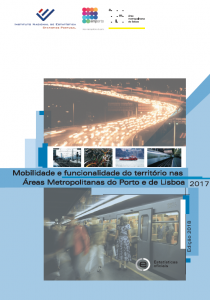
The definitive results of the Mobility Survey (IMob) conducted by INE – Portuguese Statistics Institute in 2017 in the Metropolitan Areas of Porto (AMP) and Lisbon (AML) have just been published.
The survey was answered by almost 100 thousand inhabitants from the two metropolitan areas, subdivided into three parts:
- characterization of the resident population from the perspective of mobility (mobile population), including socio-economic information and mobility expenditure;
- analysis of the mobility in the metropolitan area, considering the total trips, according to the residence of the respondent, and intra-metropolitan trips (origin and destination in the metropolitan area);
- opinions of the residents, showing reasons for using individual and public transport, as well as their evaluation of public transport.
When the transition towards a more sustainable mobility system receives increasing attention from researchers, planners and popular movements in Portugal, the results of the Mobility Survey (IMob) 2017 confirm the prevalence of a car-centred mobility model, as passenger cars were the main means of transportation used by residents of the metropolitan areas of Porto (67.6% of trips) and Lisbon (58.9%). The unsustainability of this model is further reinforced by the car occupancy rate, which was 1.56 persons in AMP and 1.60 in AML.
The soft modes (pedestrian or bicycle) appear as the second most important way of locomotion in the total number of journeys, with a combined weight of 18.9% in AMP and 23.5% in AML, though bicycle use is residual in both cases (with a modal share of 0.4% in AMP and 0.5% in AML).
The use of public and/or collective transport as the main means of transportation, accounted for 11.1% of journeys in AMP and 15.8% in AML.
Considering the specificity of bicycle commuting, it is interesting to note that, in AMP, bicycle trips last on average 35.9 minutes for an average distance of 9.5 km, comparing with journeys on foot that last on average 24.5 minutes for an average length of 2.3 km. In AML, the bicycle as the main mode implied an average duration of 36.2 minutes for an average distance 8.8 km, while the pedestrian mode was used for journeys with an average duration of 17.0 minutes and an average length of 1.5 km.
In AMP, Póvoa do Varzim is the municipality with the highest percentages of bicycle commuting (1.96%), followed by Oliveira de Azeméis (1.56%). In AML, this percentage is higher in Cascais (1.41%), followed by Alcochete (1.31%).
The data now disclosed reinforce the relevance of project BooST to address the specific needs and boost the use of bicycle in starter cycling cities, as is the case of Portuguese cities where cycling modal share is much lower than 10%.
The full report and databases are available here.
